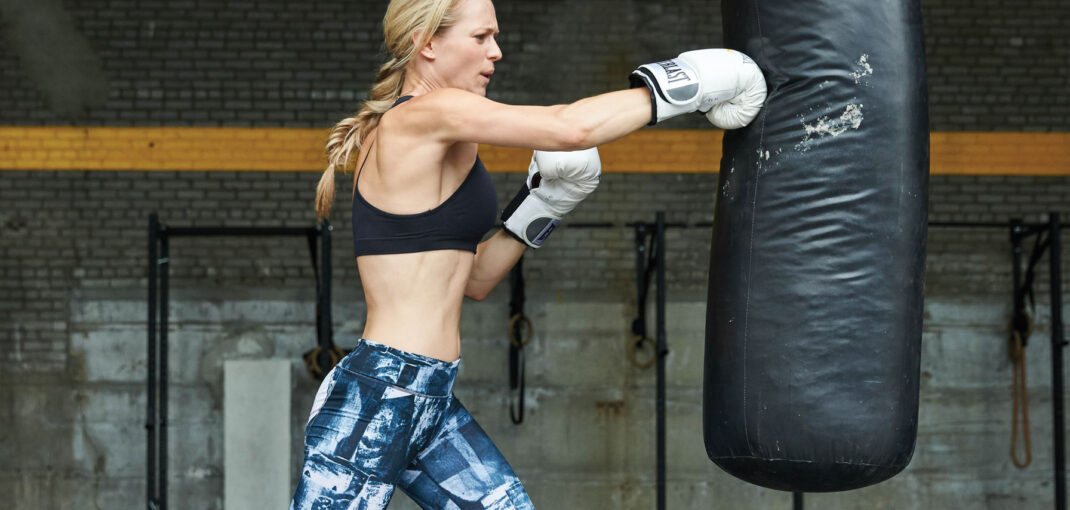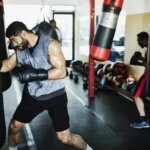Are you thinking of increasing core stamina and building upper-body strength? Consider getting a punching bag.
When most people hear the word “punching bag,” they immediately think of a leather bag filled with heavy padding that people punch and kick wildly. We know of several top MMA trainers, boxers and strength trainers who use punching bags to train.
However, few people realise that several types exist for a specific purpose.
Punching bag exercises can engage the entire body and help build muscle. They are an excellent method of building coordination, balance and core stability. If you are thinking of purchasing one or want to know which one to choose, you have come to the right place.
Today, we will tell you all you need to know about the different punching bags. Let’s begin!

What Is A Punching Bag?
Before we delve into the various types, let us discuss what a punching bag is. Most people have a vague idea about it; however, it is best to know its purpose and uses before diving into the details of the different types.
There are several names by which you may have heard of this tool – punching bag, heavy bag, boxing bag, etc. It is essentially a leather bag (genuine or synthetic leather) filled with different types of padding. It is hung from a ceiling as a striking surface, primarily for training or MMA.
Most punching bags are typically filled with sand or compressed fabric. However, many people use other items like rice, a water core (in a container), a PVC tube with filling or sawdust.
The type of padding used and its density contribute to the resistance offered by the punch bags to the striker. While most people opt for hand protection (like boxing gloves or hand wraps) while striking the bag, it is not compulsory to use one.
Using padded gloves may be beneficial for the bag as it prevents it from breaking down earlier.
Types Of Punching Bags

1. Freestanding Punching Bag
Unlike traditional punching bags, a freestanding punching bag is mounted on stands. Setting up these heavy bags may be easier as you don’t need to manually drill a hole in the wall to hang the bag. For this reason, freestanding bags are more popular among boxers who exercise from home.
That said, freestanding heavy bags are not typically found in gyms and training centres. It is an ideal option if you are looking for a heavy bag that you can conveniently move out of the way when it is not in use.
While freestanding bags are ideal for portability and convenience, they are not very heavy. So, it might not be a perfect option for those who are into professional boxing or heavy training, as this tool may be too light for them to train on.
Pros:
- Easy installation and transportation
- It does not take up too much space
- Can be moved out of the way when it isn’t in use
- Excellent for slow striking
- Lightweight and applies less pressure on the knuckles
Cons:
- May topple over easily
- Not heavy enough for professional use
2. Aqua Bag
As the name suggests, an aqua bag is filled with water instead of heavy padding. These heavy bags have gained popularity very recently. Unlike traditional heavy bags made of leather, aqua bags are made of thick synthetic material.
Striking an aqua bag offers a different experience as each strike sinks deeper, enabling you to throw harder punches. The lower resistance provided by the bag is said to be better for those with joint problems.
Remember that the typical aqua bag is heavier than a regular heavy bag. It may offer less swing with each punch. These punch bags are excellent for boxing; however, the uncomfortable material dissuades most people from using their elbows and knees on them.
Pros:
- Easier on the joints and knuckles
- Offers less resistance
- Less stress on the body
- Does not develop hard and soft spots after prolonged use
- Feels more realistic (like hitting a real person)
Cons:
- Heavier than traditional punching bags
- Not ideal for striking with knees and elbows
3. Wrecking Ball Heavy Bag
A wrecking ball heavy bag is typically very heavy and does not offer many swings, making it ideal for boxing practice. The rounded body of this bag is perfect for practising uppercuts. The bag’s weight enables you to land each punch with immense power.
These punch bags are excellent for mastering the technique of weaving and bobbing between strikes. This is primarily due to its short height and rounded structure. Furthermore, these bags have a very low swing and are excellent for practising kicking, kneeing, and close-distance fighting.
Pros:
- Ideal for practising close-combat fighting
- Excellent for practising uppercuts
- Enables boxers to stay light on their feet
- Ideal for moving around while boxing
Cons:
- The bottom can harden over time, making it unusable
4. Teardrop Heavy Bag
A teardrop bag is a versatile tool that you can use for a variety of boxing exercises. As such, you can find these bags in different styles and sizes. The larger and wider the bag, the heavier it is. The larger teardrop heavy bags are ideal for punching with power and building core stability and upper-body strength.
Moving on, the slimmer and more lightweight teardrop heavy bags are ideal for defence training and head movement. These bags have better swing and movement, allowing you to enhance mobility.
One of the most significant advantages of heavy teardrop bags is that they enable you to practice various movements. These include uppercuts, hitting with elbows and knees, lower cuts, overhand strikes, and many other types of punches.
However, kicking these bags may not feel as satisfying as doing the same on straight heavy bags.
Pros:
- Excellent for practising various punch types
- Good for defence training
- Allows you to hit the bag at various angles
- Ideal upper body workout and training
Cons:
- Not the best type to practice kicks and knee punches
5. Angled Heavy Bag
The next heavy bag has a distinct appearance which helps you distinguish it from traditional heavy bags. The angled heavy bag has a wide top and a narrow bottom, typically divided between two sections. Over time, the distinction between the two sections becomes more pronounced because of their continual use.
The angled design of this heavy bag provides an excellent surface for you to practice uppercuts. The lower section is fantastic for practising body shots and other angled punches and kicks. You can practice different punches, hooks, and body shots thanks to this heavy bag’s immense surface and angled design.
While most standard heavy bags allow you to practice specific punches and shots, the angled heavy bag is ideal for combination shots.
Pros:
- Ideal for combination shots
- Dual surface provides more space for practice
- Heavy with a good swing
- Enables you to practice angled hooks, which aren’t possible on other heavy bags
Cons:
- Extremely heavy and can be challenging to hang
6. Banana Heavy Bag
Although you may think a heavy banana bag resembles a banana, this isn’t the case. These heavy bags are essentially thin and long and look distinctly different from standard heavy bags. However, they are incredibly beneficial for specific training and workout types.
Typically, a heavy banana bag hangs low enough for the bottom to touch the ground’s surface. You may even come across some designs that attach to the floor. This design is immensely popular in Thailand, as several trainers and fitness enthusiasts enjoy using it for kickboxing and other types of strength training.
The design of the banana heavy bag makes it ideal for low punches and kicks. It is also excellent for practising body shots and elbow and knee shots. It can be treated as an opponent due to its height and structure.
That being said, the banana-heavy bag may not be ideal for those who want to focus on boxing as a sport or workout. This heavy bag is more suited for level-changing combinations since it lacks the swing required to practice challenging boxing moves.
Pros:
- Ideal for practising level-changing combinations
- Commonly found in kickboxing arenas and gyms
- Excellent for landing low punches and kicks
- Users can practice various types of punches and body shots
- Can be treated as an opponent
Cons:
- Does not have enough swing to practice boxing
- Can be slightly challenging to set up
7. Pole Bag
The pole bag looks similar to the banana heavy bag. However, the primary distinction between them is their size and weight. If you liked the concept of the banana bag but are looking for something to help you train better, opt for the pole bag.
When filled, these bags can weigh up to 300 pounds, making them significantly heavier than standard heavy bags. However, with constant use, the bottom filling tends to get thicker, compromising the shape and structure of the bag.
The bag’s name comes from the fact that it was designed to be mounted on a pole rather than hung from the ceiling. This helps it retain some of its structure over time and allows you to pack power in every kick and punch.
Pros:
- Excellent for practising level-changing combinations
- Allows you to put immense power in every shot
- Great for practising body shots and kicks
- Sturdy and durable
- Can be mounted on a pole or hung
Cons:
- Not portable
- Loses its structure over time
8. Speed Bag
The speed bag is relatively common and popular amongst those who want to show off their hand movements and agility. With these bags, you are expected to punch your fist in a hammer-like motion rather than packing in powerful punches.
The speed bag has several benefits for your body. For starters, you need to train well to balance your movements and mobility, timing each punch perfectly with the swing of the bag. Furthermore, regular training with this bag will eventually enhance your hand-eye coordination, balance, and stability.
Pros:
- Increases hand-eye coordination
- Helps you with rhythm and control
- Easy to install
- Portable and lightweight
Cons:
- Cannot practice body, elbow, or knee shots on it
9. Body Opponent Bag
The body opponent bag is often known by its acronym – BOB. You may also come across it by its other names, such as a boxing partner bag.
These heavy bags are designed to function similarly to freestanding heavy bags. However, this bag is designed to represent a male human torso. This gives you a more realistic practice opponent and allows you to efficiently practice punching the chin, throat, ribs, and face.
These heavy bags are height adjustable. This enables you to practice body shots more precisely than standard heavy bags, where you need to guess the location of the body parts.
Pros:
- Realistic representation of an opponent
- Allows you to practice chin, head, and rib shots
- Height adjustable
- Easy to install and relatively portable
Cons:
- Easily topples over







